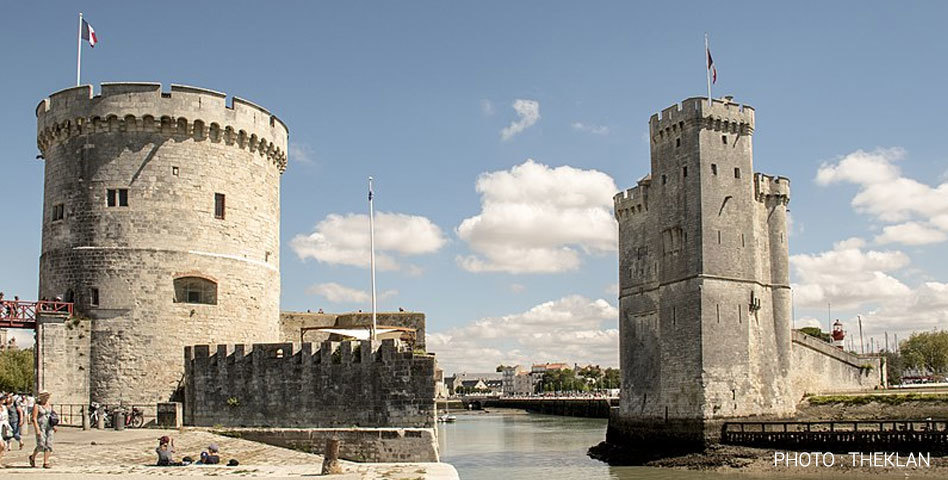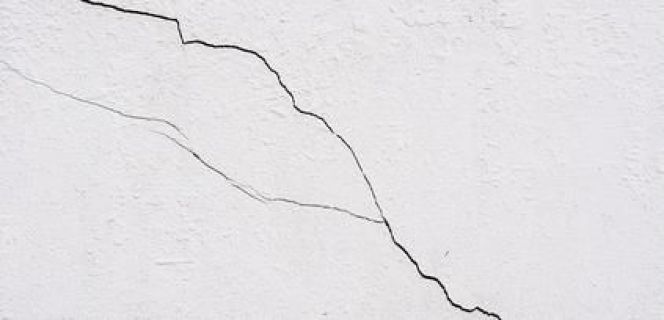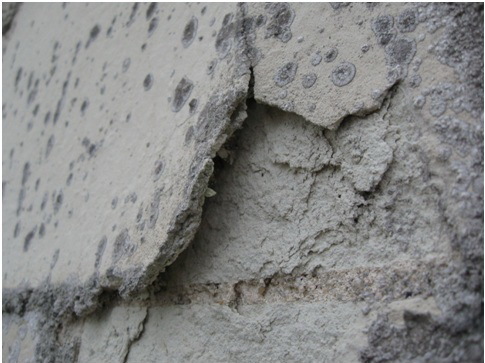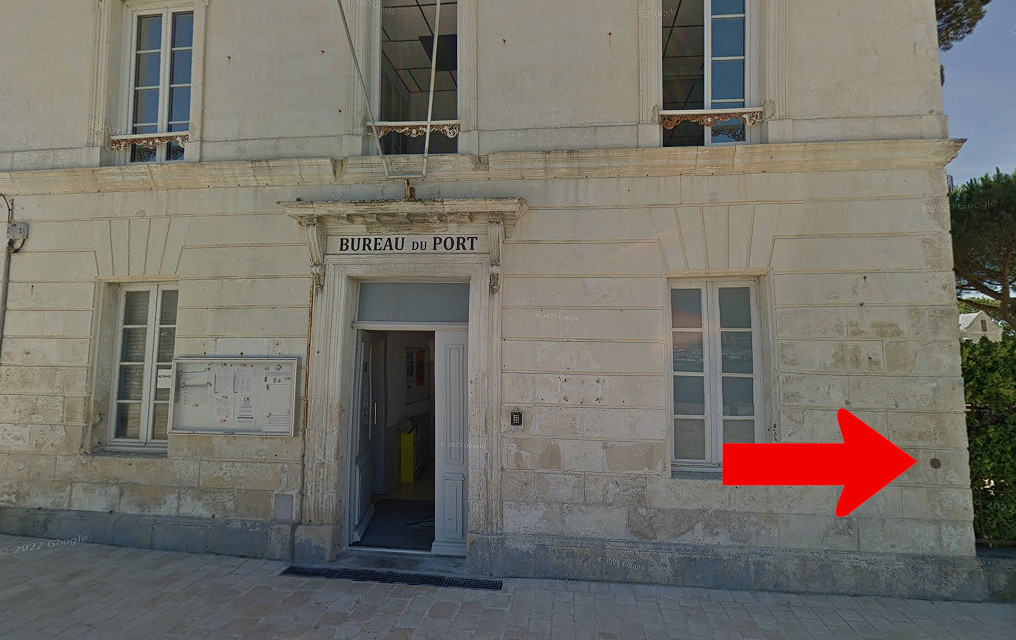
Bref historique des Tours
Saint Nicolas, de la Chaîne et de la Lanterne sont les noms portés par ces 3 monuments incontournables de la Rochelle. Essentielles au développement de la ville, elles façonnent le paysage depuis toujours, assurant différentes fonctions : protection, régulation des entrées, prisons, résidences... Construite au XVème siècle, leur apparence témoigne des siècles passés.

La légende raconte que c'est la fée Mélusine qui est à l'origine de la construction de la tour Saint-Nicolas. En réalité, la construction aurait débuté en 1345. En raison du terrain marécageux, il est décidé de mettre en place un radier constitué de longs pieux de chêne enfoncés dans 6 mètres de vase et calés à l’aide de pierres, qui fait alors office de fondations. Cependant, en raison du poids de la construction et de la nature meuble du terrain, les fondations cèdent, ce qui a pour effet de faire s'incliner l'édifice, qui présente un important devers de plus de vingt centimètres en direction de l'est. Ne parvenant pas à la redresser, les ingénieurs décident de stabiliser les fondations.
L'altération des roches
Le principal agent de dégradation de la pierre est l'eau. Principalement agressive sous sa forme d'eau de pluie, elle peut également nuire à la pierre par d'autres moyens et sous d'autres formes : ruissellements, vapeur d'eau, remontée capillaire, alterance de gel et dégel... L'effet de l'eau sur une pierre dépend de sa nature et de ses caractéristiques physiques (porosité). Ainsi, si certaines pierres comme l'ardoise ou le marbre y sont résistantes, d'autres y sont beaucoup plus sensible. C'est notamment le cas des pierres calcaires.
L'eau peut aussi favoriser le développement de micro-organismes et végétations qui affectent les bâtiments. On peut observer le développement de lichens, d'algues, de mousses, de champignons... Les minéraux sont indispensables à la croissance végétales. Habituellement puisé dans le sol, les végétaux sont aussi capables d'aller les chercher dans les roches grâce aux développements de leurs racines provocant ainsi une altération. De plus, les racines et les rhizoïdes produisent des ions H+ connus pour acidifier le milieu et donc, accélérer l'altération chimique des minéraux. Cette altération est différente selon le type de substrat.
D'autres causes d'altération sont liées à la pollution atmosphérique qui conduit la pierre à présenter des salissures noires dû aux sulfures. Le sel fait également subir à la pierre une réaction chimique qui accélère le processus de dégradation appelé haloclastie. Les solutions salines pénètrent la roche via les pores et autres fissures et lors de l'évaporation, les sels cristallisent, exerçant alors une pression importante. La répétition de ce cycle entraine différentes dégradations sur les roches.
On recense 3 grands types d'altérations :
- Biologique, sous l'effet d'êtres vivants.
- Physique, sous l'effet du climat.
- Chimique, sous l'effet des gaz et des ions.
Quelques exemples d'altérations :




Questions
📍 Waypoint 1 📍
1) 🔎Pouvez vous observer un ou différents types d'altérations sur cette tour ? Si oui, nommer-la/les ?
2) 🔎Un coté vous semble t'il plus atteint (Nord, Sud, Ouest, Est)? Cela est-il logique (argumentez en quelques mots)?
▶️Observation depuis plusieurs angles de vue peuvent être utiles.
3) 🔎✏️Rendez vous à la croix rouge sur la photo ci dessous, que pouvez-vous observer (si vous ne l'avez pas déjà observé auparavant) ? Cela vous semble t'il inquiétant ? Aller de l'autre coté du mur (à l'opposé) : que voyez vous ? Expliquer la probable origine de ce phénomène. N'hésitez pas à revenir sur la question lorsque vous aurez pris un peu de recul sur la tour (plus loin dans le port).
🔎Optionnelle : rendez vous au pied de la tour du coté nord (croix jaune).Observer les éléments présent au pieds de la Tour. Cela pourrait vous être utile lors de la question 7.

📍Waypoint 2 📍
4) 🔎✏️Observez vous de l'altération sur ce batiment ? Si oui, laquelle ? Observer sur la droite de la devanture le petit "médaillon" (cf photo si dessous) : ce phénomène peut-il expliquer les différentes dégradations que vous observez ? Justifier selon des observations visuelles.

📍Waypoint 3📍
5) 🔎La roche utilisé est elle la même que pour la tour Saint Nicolas ? Y a t'il une altération ? Si oui, est-ce la même ?
📍Waypoint 4📍
6) 🔎La roche utilisé est elle la même que pour la tour Saint Nicolas ? Y a t'il une altération ? Si oui, est-ce la même ?
7) ✏️Selon vous, les tours de La Rochelle sont elles malades ? Justifier votre réponse.
8) 📸Prenez une photo de vous, ou d'un objet personnel où l'on voit les 3 Tours depuis la Tour de la Lanterne.

Brief history of the Tours
Saint Nicolas, de la Chaîne and de la Lanterne are the names of these 3 must-see monuments in La Rochelle. Essential to the development of the city, they have always shaped the landscape, ensuring different functions: protection, regulation of entrances, prisons, residences... Built in the 15th century, their appearance bears witness to past centuries.

Legend has it that it was the fairy Mélusine who was behind the construction of the Saint-Nicolas tower. Construction is said to have started in 1345. Due to the marshy terrain, it was decided to set up a raft consisting of long oak piles driven into 6 meters of mud and wedged with stones, which then served as a foundation. However, due to the weight of the construction and the loose nature of the ground, the foundations give way, which has the effect of leaning the building, which has a significant slope of more than twenty centimeters towards the east. East. Unable to straighten it, the engineers decided to stabilize the foundations.
The main degrading agent of stone is water. Mainly aggressive in its form of rainwater, it can also harm the stone by other means and in other forms: runoff, water vapour, capillary rise, alternation of freezing and thawing... effect of water on a stone depends on its nature and its physical characteristics (porosity). Thus, if certain stones such as slate or marble are resistant to it, others are much more sensitive to it. This is particularly the case with limestone.
Water can also promote the development of micro-organisms and vegetation that affect buildings. We can observe the development of lichens, algae, mosses, fungi... Minerals are essential for plant growth. Usually drawn from the ground, the plants are also able to get them from the rocks thanks to the development of their roots, thus causing an alteration. In addition, roots and rhizoids produce H+ ions known to acidify the environment and therefore accelerate the chemical alteration of minerals. This alteration is different depending on the type of substrate.
Other causes of alteration are linked to atmospheric pollution which leads the stone to present black stains due to sulphides. Salt also causes the stone to undergo a chemical reaction that accelerates the degradation process called haloclasty. Saline solutions penetrate the rock through pores and other cracks and during evaporation, the salts crystallize, then exerting significant pressure. The repetition of this cycle leads to various degradations on the rocks.
There are 3 main types of alterations:
- Biological, under the effect of living beings.
- Physical, under the effect of the climate.
- Chemical, under the effect of gases and ions.
Some examples of alterations:
- The crack is a sudden discontinuity appearing in a material under the effect of internal or external stresses, where the material is separated on a certain surface.


- Desquamation is affected by the detachment of surface lamellae or scales.

- Cryoclasty is a process of breaking up rocks, caused by the cycles of freezing and thawing of water. The ice contained in the porous network of the rocks can therefore exert significant pressures within the rock.

📍 Waypoint 1 📍
1) 🔎 Can you observe one or different types of alterations on this tower? If so, name it/them?
2) 🔎Does one side seem more affected (North, South, West, East)? Does this make sense (argue in a few words)?
▶️ Observation from several angles of view can be useful.
3)🔎✏️Go to the red cross in the photo below, what can you see (if you haven't seen it before)? Does this seem worrying to you? Go to the other side of the wall (opposite): what do you see? Explain the probable origin of this phenomenon.
🔎Optional: go to the foot of the tower on the north side (see photo below). Observe the elements present at the foot of the Tower. This may be useful to you during question 7.
📍Waypoint 2 📍
4) 🔎✏️ Do you observe any alteration on this building? If yes which one ? Observe on the right of the front the small "medallion" (see photo below): can this phenomenon explain the various degradations that you observe? Justify based on visual observations.
📍Waypoint 3📍
5) 🔎 Is the rock used the same as for the Saint Nicolas tower? Is there any alteration? If so, is it the same?
📍Waypoint 4📍
6) 🔎 Is the rock used the same as for the Saint Nicolas tower? Is there any alteration? If so, is it the same?
7) ✏️ In your opinion, are the towers of La Rochelle sick? Justify your answer.
8) 📸Take a picture of yourself, or a personal item showing the 3 Towers from the Tower of La Lanterne.
Sources :
- https://www.encyclopedie-environnement.org/vivant/lichens-surprenants-organismes-pionniers/
- https://coursgeologie.com/types-d-alteration-des-roches-220/#:~:text=2.-,L'ALTERATION%20BIOLOGIQUE,dans%20des%20fractures%20de%20roches).
- https://eduterre.ens-lyon.fr/thematiques/hydro/erosion/alteration